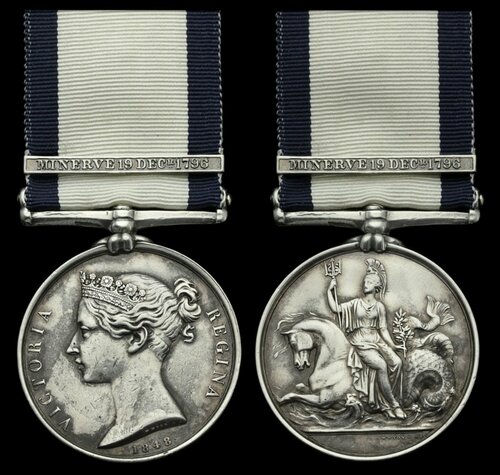
Auction: 21002 - Orders, Decorations and Medals
Lot: 2
The rare Naval General Service Medal awarded to Able Seaman Joseph Clark, who served in two celebrated frigate actions, concluding his career aboard H.M.S. Minotaur at Trafalgar
Naval General Service 1793-1840, 1 clasp, Minerve 19 Decr. 1796 (Joseph Clark.), suspension re-fitted, contact marks, nearly very fine
A unique name upon the rolls.
Entitled to 'Blanche 4 Jany. 1795' and 'Trafalgar' clasps. Another Medal with those two clasps was sold in the Goddard Collection, noting the likely existence of this award.
Joseph Clark was born at Deptford, Kent in 1779. He entered the muster book of H.M.S. Blanche, a 32-gun sixth rate, as a Boy 3rd Class on 10 September 1792, and was present at Blanche's capture of the French frigate Pique, 38 guns, on 4 January 1795. Blanche, under Captain Robert Faulknor, was cruising off Guadaloupe when she discovered Pique at anchor outside the harbour of Pointe-à-Pitre. Pique scurried away with all her sails spread and Blanche gave chase for twelve hours before eventually coming alongside. The two vessels traded broadsides just after midnight; the action became desperate at 2.30 a.m. when Blanche's main and mizzen masts fell. Captain Faulknor was shot through the heart attempting to lash Pique's bowsprit to Blanche's capstan. Assuming command, Lieutenant Watkins succeeded in this bold endeavour, which enabled Blanche to tow her antagonist into the wind. Marksmen in Pique's foc'sle brought heavy fire to bear on Blanche's quarterdeck, but were quickly silenced by grapeshot from Blanche's stern chasers. The French withstood this galling fire until 5 a.m., when they struck their colours. Such was the intensity of the firefight that not a single boat remained intact on either ship: Lieutenant Milne, with ten seamen, had to swim aboard Pique to take possession of her. By Act of Parliament, a monument to Captain Faulknor's memory was erected in St. Paul's Cathedral. Only five clasps were issued to surviving men who took part in this action.
Clark continued to serve aboard Blanche, witnessing the dramatic 'Blanche Mutiny' of 1796. Captain Charles Sawyer took command of Blanche following Pique's capture, and became deeply unpopular with the crew due to his blatant homosexual relations with two midshipmen and his coxswain. The Captain Sawyer of 'Hornblower' fame appears closely based on this depraved, real-life character, who inflicted sadistic punishments on any who dared to challenge his rule. Blanche's First Lieutenant, Archibald Cowan, wrote to Captain George Cockburn, the fleet's senior Captain, charging Sawyer of 'odious misconduct'. Sawyer was court-martialled on 17 October 1796, and judged 'incapable of ever serving in any military capacity whatever.' These events were recorded by the American seaman and diarist Jacob Nagle, who served on Blanche alongside Clark.
Even before this infamous trial, Admiral Sir John Jervis had found Blanche a new Captain, D'Arcy Preston, who led her against the Spanish frigates Santa Sabina and Ceres off Cartagena on 19 December 1796. H.M.S. Minerve, 40 guns, lent support. Though Clark was still part of Blanche's crew, appearing on her muster book, he was 'lent' to H.M.S. Minerve, 40 guns, for this daring action, thus receiving a 'Minerve 19 Decr. 1796' clasp. He served alongside a certain Commodore Horatio Nelson, who hoisted his broad pennant aboard Minerve and directed the action from her quarterdeck. According to Nelson's account, Minerve engaged the Sabina at 10.40 p.m. and shot away her mizzen mast, inflicting 164 casualties. Minerve struck her colours at 12.30 a.m., and Nelson put aboard her a prize crew of 42 men led by Lieutenants John Culverhouse and Thomas Hardy (of Trafalgar fame). Just as Minerve was preparing to tow away her prize, the Spanish frigate Matilda arrived from nowhere, followed by four more Spanish ships including the Principe-de-Asturias, 112 guns. After a desperate struggle, the prize crew were obliged to surrender. Culverhouse, Hardy and the surviving men were imprisoned but later released. Their brave stand enabled Minerve, with Nelson aboard her, to slip away and rendezvous with Sir John Jervis, bringing vital intelligence of the Spanish fleet.
Clark served as an Able Seaman aboard H.M.S. Minotaur, 74 guns, at Trafalgar. Her Captain, Charles Mansfield, famously pledged to his crew that he would stick to any ship engaged 'till either she strikes or sinks - or I sink.' At the climax of the battle, he deliberately placed Minotaur between the damaged Victory and an attacking French ship; he was later awarded a Patriotic Sword and Gold Medal for this gallant act. Both are now in the National Maritime Museum. Clark was one of 16 men from the crew of Minotaur who lived to receive a 'Trafalgar' clasp. The 1851 Census shows that he returned to Deptford, living with his wife Hanna at 20 Old King Street. He died that same year.
Subject to 20% VAT on Buyer’s Premium. For more information please view Terms and Conditions for Buyers.
Estimate
£8,000 to £10,000
Starting price
£7500




